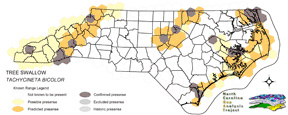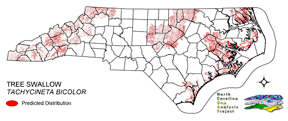
| Taxa: |
| Order: |
| Family: |
| Aves |
| Passeriformes |
| Hirundinidae |
| NatureServe Global Rank: |
| NatureServe State (NC) Rank: |
| G5 |
| S3B,S4N |
| Federal Status: |
| NC State Status: |
| --- |
| W2 |


| Land Unit |
| US Fish & Wildlife Service |
| US Forest Service |
| US National Park Service |
| US Department of Defense |
| NC State Parks |
| NC University System |
| NC Wildlife Res. Com. |
| NC Forest Service |
| NC Div. of Coastal Mgmt. |
| Local Governments |
| Non-Governmental Org. |
| Other Public Lands |
| Private Lands |
| GAP Status 1-2 |
| All Protected Lands |
| Statewide |
| Hectares |
| 20,716.56 |
| 17,809.56 |
| 20,620.44 |
| 8,387.55 |
| 2,499.93 |
| 93.15 |
| 6,692.94 |
| 187.65 |
| 2,134.62 |
| 733.68 |
| 2,149.29 |
| 1,736.28 |
| 939,677.85 |
| 39,930.84 |
| 81,851.76 |
| 1,023,439.50 |
| Acres |
| 51,191.72 |
| 44,008.37 |
| 50,954.21 |
| 20,726.08 |
| 6,177.46 |
| 230.18 |
| 16,538.61 |
| 616.26 |
| 5,274.76 |
| 1,812.96 |
| 5,311.01 |
| 4,290.44 |
| 2,321,994.08 |
| 98,823.80 |
| 202,412.63 |
| 2,529,126.15 |
| % of Dist. on |
| Prot. Lands |
| 25.3 % |
| 21.8 % |
| 23.0 % |
| 10.2 % |
| 3.1 % |
| 0.1 % |
| 8.2 % |
| 0.2 % |
| 2.6 % |
| 2.6 % |
| 2.6 % |
| 2.0 % |
| 0.0 % |
| 48.8 % |
| ----- |
| ----- |
| % of Dist. on |
| All Lands |
| 2.0 % |
| 1.7 % |
| 2.0 % |
| 0.8 % |
| 0.2 % |
| < 0.1 % |
| 0.7 % |
| < 0.1 % |
| 0.2 % |
| < 0.1 % |
| 0.2 % |
| 0.2 % |
| 91.8 % |
| 3.9 % |
| ----- |
| ----- |
|
May breed occasionally on the coast (Fussell 1994) and uncommonly to rarely in the mountains (Simpson 1992). Nests in open or semi-open habitats that supply flying insects and nesting cavities; especially near water, but also away from it in meadows and shrubby areas (Kaufman 1996). Nests in a variety of cavities, usually at least 5 feet above the ground (Ehrlich et al. 1988). Will use natural tree cavities, old woodpecker holes, or holes in the ground or in buildings. Uses cavities of exactly the same size as the Eastern Bluebird, and will usurp nest boxes erected for the species (Kaufman 1996). Will eat berries when no insects are available (Ehrlich et al. 1988). NATURE SERVE GLOBAL HABITAT COMMENTS: Open situations near water, including streams, lakes, ponds, marshes and coastal regions (AOU 1983); savanna, pastures, etc. Nests usually near water in a natural tree cavity or abandoned woodpecker hole, less frequently in open woodland away from water. Also nests in bird boxes or in a crevice in a building. Territoriality may limit use of suitable nest sites. Tends to return to same nest site in subsequent years if reproduction successful; first-year breeders return to nest usually within 100 km or less of natal site (Turner and Rose 1989). |
| Code | Name | Description | NC Natural Heritage Program Equivalent |
| 3 | Tidal Marsh | Fresh and brackish tidal marshes, including cord grass, wild rice, sawgrass and needlerush alliances. | Brackish Marsh, Interdune pond, Maritime wet grassland |
| 124 | Maritime Scrubs and Tidal Shrublands | Coastal shrubs including wax-myrtle, swamp rose, alder, yaupon, and greenbriar. | Maritime Shrubs, Salt Shrub |
| 372 | Interdune Herbaceous Wetlands | Dune swales with permanently flooded to intermittently exposed hydrology. Species composition depends on salinity and can include cut grass, spike-rush, mosquito fern, and hornwort. | Interdune Pond, Maritime Wet Grasslands |
| 371 | Maritime Grasslands | Dune grass community consisting of sea oats and beach grasses. | Dune grass, Maritime dry grassland |
| 380 | Coastal Plain Fresh Water Emergent | Emergent vegetation in fresh water seepage bogs, ponds and riverbeds of the coastal plain. Includes alliances dominated by sedges, eelgrass, as well as cane found in unforested cane-brakes. | Small Depression Pond, Sandhill Seep, Floodplain Pool, Unforested Floodplain Canebrake, Riverscour Prairies, Vernal Pools |
| 173 | Coastal Plain Riverbank Shrubs | Shrub dominated riverbanks, commonly dominated by willows and/or alders. | Sand and Mud Bar |
| 78 | Pond-Cypress - Gum Swamps, Savannas and Lakeshores | Cypress dominated swamps and lakeshores. Can include bays dominated by pond cypress or shorelines of coastal plain lakes with a narrow band of cypress. | Non-riverine Swamp Forest, Natural Lakeshores (in part) |
| 87 | Pocosin Woodlands and Shrublands | Includes pond pine woodland, low pocosin and high pocosin shrub dominated areas. Canebrakes and bay forests may be present. | Pond Pine Woodlands, Peatland Canebrake, Small Depression Pocosin |
| 67 | Wet Longleaf or Slash Pine Savanna | Wet flatwoods and pine savannas, typically dominated by longleaf pines, but slash or pond pines may be the dominant pines. | Wet Pine Flatwoods |
| 97 | Mesic Longleaf Pine | Longleaf pine woodlands without a major scrub oak component. Slash or loblolly pines may be present as well. | Mesic Pine Flatwoods |
| 42 | Xeric Longleaf Pine | Sandhills including a range of longleaf pine density from predominantly wiregrass, scrub oak dominated to true longleaf pine woodland. This does not include mesic or saturated flatwood types. | Xeric Sandhill Scrub, Pine/Scrub Oak Sandhill, Coastal Fringe Sandhill |
| 238 | Piedmont/Mountain Submerged Aquatic Vegetation | Seasonally to permanently flooded areas with aquatic vegetation. Waterlily, pondweed, hydrilla smartweed are a few of the species that can occur. | Piedmont/Mountain Semipermanent Impoundment (in part) |
| 239 | Piedmont/Mountain Emergent Vegetation | Emergent vegetation of all wetland hydrologies. Sites would commonly support species such as tussock sedge, rushs, and cattail alliances. | Rocky Bar and Shore (in part) |
| 267 | Riverbank Shrublands | Riverside shrubs with temporarily flooded hydrologies. Found in the both the Mountains and Piedmont. Containing dominants such as smooth alder and a Carolina or black willows. | Sand and Mud Bar |
| 269 | Floodplain Wet Shrublands | Saturated shrublands of the Piedmont, includes buttonbush, swamp-loosestrife, decodon and alders. | Piedmont/mountain Semipermanent Impoundment |
| 226 | Piedmont Xeric Woodlands | Generally post and blackjack oak dominated woodlands. White ash and pignut hickory can be found in combination with Eastern red cedar on glades. | Xeric Hardpan Forest |
| 20 | Coniferous Regeneration | Regenerating pine stands. Predominantly loblolly pine, but slash and longleaf stands occur as well. | No equivalent |
| 36 | Successional Deciduous Forests | Regenerating deciduous trees with a shrub stature. Commonly dominated by sweetgum, tulip poplars and maples. | No equivalent |
| 180 | Agricultural Crop Fields | Farm fields used for row crops. | No equivalent |
| 205 | Agricultural Pasture/Hay and Natural Herbaceous | Farm fields used for pasture grass or hay production, as well as old fields dominated by native and exotic grasses. | No equivalent |
| 202 | Residential Urban | Includes vegetation interspersed in residential areas. Includes lawns, mixed species woodlots, and horticultural shrubs. Vegetation accounts for between 20 - 70% of the cover. | No equivalent |
| 8 | Open water | Open water without aquatic vegetation. | No equivalent |
| 533 | Appalachian Swamp Forest | Evergreen and deciduous forests with saturated hydrologies. This class may contain a variety of trees species, including hemlock - red maple, pitch pine, and white pine forests. | Swamp Forest-Bog Complex, Southern Appalachian Bog, Southern Appalachian Fen |
| 534 | Appalachian Wet Shrubland/ Herbaceous | Saturated shrubs and herbaceous vegetation. Often mapped as an inclusion in Appalachian Swamp Forest. | Southern Appalachian Bog, Southern Appalachian Fen |
|
Smith, P.W., and S.A. Smith. 1990. The identification and status of the Bahama swallow in Florida. Birding 22:264-271.
Lee, D. S. 1993. Range expansion of the tree swallow, TACHYCINETA BICOLOR (Passeriformes:Hirundinidae), in the southeastern United States. Brimleyana 18:103-113. Sheldon, F. H., and D. W. Winkler. 1993. Intergeneric phylogenetic relationships of swallows estimated by DNA-DNA hybridization. Auk 110:798-824. Simpson MB Jr. 1992. Birds of the Blue Ridge Mountains. Chapel Hill and London: University of North Carolina Press. Fussell, J.O. III. 1994. A birderís guide to coastal North Carolina. Chapel Hill and London: The University of North Carolina Press. Kaufman K. 1996. Lives of North American Birds. Boston, New York: Houghton Mifflin Company. Lumsden, H. G. 1989. Test of nest box preferences of eastern bluebirds, SIALIA SIALIS, and tree swallows, TACHYCINETA BICOLOR. Can. Field-Nat. 103:595-597. Oberholser, H.C. 1974. The bird life of Texas. 2 vols. Univ. of Texas Press, Austin. Godfrey, W.E. 1966. The birds of Canada. National Museums of Canada. Ottawa. 428 pp. Harrison, C. 1978. A field guide to the nests, eggs and nestlings of North American birds. Collins, Cleveland, Ohio. Terres, J.K. 1980. The Audubon Society encyclopedia of North American birds. Alfred A. Knopf, New York. American Ornithologists' Union (AOU), Committee on Classification and Nomenclature. 1983. Check-list of North American Birds. Sixth Edition. American Ornithologists' Union, Allen Press, Inc., Lawrence, Kansas. National Geographic Society (NGS). 1983. Field guide to the birds of North America. National Geographic Society, Washington, D.C. Raffaele, H.A. 1983. A guide to the birds of Puerto Rico and the Virgin Islands. Fondo Educativo Interamericano, San Juan, Puerto Rico. 255 pp. Ehrlich, P.R., D.S. Dobkin, and D. Wheye. 1988. The birder's handbook:a field guide to the natural history of North American birds. Simon and Shuster, Inc., New York. xxx + 785 pp. Mitchell, W.A. 1988. Songbird nest boxes. Section 5.1.8, U.S. Army Corps of Engineers, Wildlife Resources Management Manual. Tech. Rep. EL-88-19. Waterways Experiment Station, Vicksburg, Mississippi. 48 pp. Ridgely, R.S., and G. Tudor. 1989. The birds of South America. Vol. 1. The Oscine passerines. Univ. Texas Press, Austin. 516 pp. Stiles, F.G., and A.F. Skutch. 1989. A guide to the birds of Costa Rica. Comstock Publ. Associates, Cornell University Press, Ithaca, New York. 511 pp. Turner, A., and C. Rose. 1989. Swallows and martins an identification guide. Houghton Mifflin Co., Boston. |
For more information please contact them at:
NC-GAP Analysis Project
Dept. of Zoology, NCSU
Campus Box 7617
Raleigh, NC 27695-7617
(919) 513-2853
www.basic.ncsu.edu/ncgap